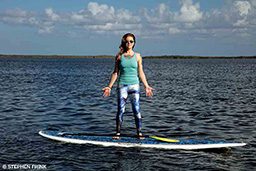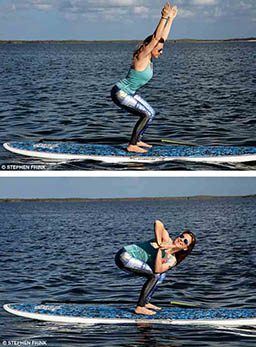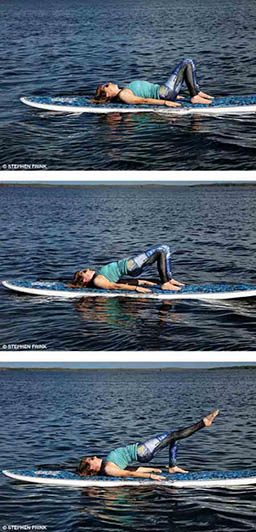Stand-up paddleboards (SUPs) may look intimidating, but most boards these days are relatively simple to handle and are available in all shapes and sizes. Yoga on an SUP is similar to traditional land-based yoga, but it occurs in a dynamic environment, which may include changes in wind and current that require more mindfulness. Simple poses require added focus on breath, balance and core stability, similar to the core strength and mental focus used during scuba diving.
You will benefit from immediate feedback (your board tilting) if you are off balance, and you will be amazed by your stability when you return to land-based yoga.
General tips:
- Hydrate in advance, since accessing your water bottle during your practice can be challenging.
- Consider the sun. Too much sunscreen can make your body slippery, so you may want to opt for a rash guard instead.
- Try to keep your center of gravity over the center of your board.
- Make sure that your board is in a suitable location with minimal currents or a location where you can safely drift.
- Have sufficient clearance around your board if (when) you fall into the water. Water is soft, so have fun!
Complete this series of poses (or whichever ones you feel comfortable with) in the following order. Repeat the series three times.
Mountain Pose (Tadasana)

- Stand in the middle of your board (usually marked by the hand well) with your feet shoulder width apart.
- Roll your shoulders up toward your ears, and retract your shoulder blades.
- Take five slow, deep, cleansing breaths.
Tip: Focus your eyes on the horizon, and keep your spine tall. Bending over is a surefire way to end up in the water.
Twisting Chair Pose (Parivrtta Utkatasana)

- Stand with your feet hip width apart. Bend at your knees into a squat position, and keep your feet pointing forward.
- Tip: Start with a slight bend in your knees, and progress toward 90 degrees.
- Keep a flat back, and raise your arms straight by your ears. Lean back slightly as you hinge forward.
- Tip: Your weight should be in your heels, and there should be a straight line from your fingertips to your buttocks.
- Bring your palms together in a prayer position with your elbows out to the side. Take five slow, deep breaths, and (if you feel stable and comfortable) progress to the twist (steps 4-7).
Challenge:
- Exhale, and rotate toward the right through your spine, torso and shoulders.
- Maintain the squat and hinged position.
- Look toward the sky and hold for 20 seconds.
- As you untwist, inhale and repeat for the other side.
- Return to center, and assume a seated position.
Bridge Pose (Setu Bandha Sarvangasana)

- Lie with your back on the board. Keep your knees parallel, and bend them so your feet are close to your buttocks.
- Press your arms by your side, exhale, and lift your buttocks off the floor.
- Tip: Keep your shoulders relaxed to lift your hips higher off the board.
- Hold this position for 30 seconds, and relax your back to the board.
- Repeat five times.
Challenge: Once your hips are lifted, lift one leg straight, and keep it parallel with your other knee. Hold for 20 seconds, and repeat with the other leg.
Boat Pose (Paripurna Navasana)

- Sit on the board with your feet straight out in front of you and squeezed together.
- Place your hands down at your sides so your fingers are pointed straight ahead.
- Exhale, and use your abdominals to lift your legs straight as you lean back to balance on your tailbone.
- Tip: Try to keep a flat back to prevent any rounding or sinking of the spine.
- Reach your arms in front of you so they are angled toward your calves.
- Hold for 10 seconds.
- Repeat five times.
Challenge: Slowly raise your arms to your ears while balancing on your tailbone and keeping your legs straight. Hold for 10 seconds.
Upward Plank Pose (Purvottanasana)

- Sit on the board with your feet straight out in front of you and squeezed together.
- Slide your buttocks forward to create more space between it and your hands.
- Bend your elbows so they point behind you. Make sure your fingers are still pointed forward.
- Exhale, and press your palms to the board as you lift your hips.
- Lift your hips up until your back and thighs are off the board.
- Keep your legs together and straight, and press the bottoms of your feet into the board.
- Look toward the sky and hold for 30 seconds.
- Repeat five times.
Tip: Your shoulders should be directly over your wrists.
NOTE: To avoid an increased risk of decompression sickness, DAN® recommends that divers avoid strenuous exercise for 24 hours after making a dive. During your annual physical exam or following any changes in your health status, consult your physician to ensure you have medical clearance to dive.
| © Alert Diver — Q2 2018 |